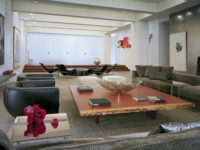Most architects who design shops, art galleries, or even museums know too well the need for a delicate balance. You have to create a setting discreet enough for the goods or objects on display to stand out, while designing an architectural environment alluring enough to induce visitors to linger, look—and maybe buy.
Additional Information:
Jump to credits & specifications
A prime example of this intricate interaction between the container and the contained is the two-story boutique 1436 Erdos in Beijing’s Kerry Centre, a centrally located office, hotel, apartment, and shopping complex. The New York firm Gabellini Sheppard Associates designed the 4,300-square-foot luxury emporium in 2016 to foster the identity of the purveyor of high-quality cashmere accessories and clothing. The owner is the Erdos Group, named for the city (aka Ordos) in Inner Mongolia where the company was founded in 1979. Erdos has several fashion lines, including the ultraluxurious 1436 cashmere brand, a high-quality gossamerlike knit spun from the down of baby Arbus goats. Based on a formula where threads have a diameter of only 14 micrometers and a length of 36 millimeters, the product is extremely lightweight yet strong.
The head of 1436 Erdos, a Cambridge University–trained engineer, Wang Zhen, began opening its stores in China in 2006 before turning to Gabellini Sheppard to design a new flagship in Beijing. She admired the firm’s understated approach to fashion, which she first encountered through its Jil Sander store in Paris (1993) and, later, in the handful of Salvatore Ferragamo shops in Italy. Meanwhile, her creative director, Graeme Black, formerly a designer with both Ferragamo and Armani, was familiar with Gabellini Sheppard’s Armani Center in Milan (2000). “Zhen felt we were kindred spirits,” says principal Michael Gabellini, who intended the ambience to have a relaxed and elegant quality for its comfortable, luxurious collection. Above all, he wanted it to convey a sense of calm: “The streets of Beijing outside make New York City seem placid,” he says. The setting also needed to be flexible, relying on movable display assemblies and furnishings as 1436 expands beyond cashmere; it now features men’s and women’s attire with silks, cotton-and-nylon blends for warm weather, and it plans on adding handbags and shoes to its portfolio.
From the street, the shop, embedded in the low-rise concrete-and-steel base of the Kerry Centre, presents a tailored look: its glass and metal curtain wall is backed by a layer of vertical LED panels spaced apart to permit shafts of daylight to enter the interior. A digitally run video feed of moving images wafts over the LEDs to spark up the facade at night. Inside, a soft palette of beige and off-white oak, plaster, and travertine creates a soothing, airy background for the cashmere scarves, shawls, and other accessories displayed on the street level. (The much larger second floor carries the women’s and menswear collections.) Diaphanous fabric scrims subdivide the various areas, where spare, slightly curved oak shelves and slender rods elegantly present the merchandise. The most substantial elements in the shop are the sleek, blocklike beige wool-and-leather chairs, benches, and hassocks, which the architects also designed.
But the ethereal atmosphere dominates, even overhead, where a series of slightly overlapping, curved, cast-plaster forms installed with linear LEDs span the length of the showrooms’ ceilings on both levels. “Wang wanted us to capture the feeling of the light in Erdos, where earth and sky meet, and to approximate the serenity of the early morning or early evening,” says Gabellini.
A sculptural open-riser stairway, clad in a wood-laminated composite over a steel frame, leads to the upper level. Over a dozen sections, each formed of eight steamed-bentwood treads, are “connected like a puzzle,” says the architect. He wanted the stair to evoke “the way Graeme thinks about clothes, cutting on the bias to generate shapes that seem layered on the body.” To further dramatize the lightness of this shaped, muscular construct, he tucked LEDs strategically within its handrails.
Lighting, as is typical of a Gabellini Sheppard interior, defines spaces as well as dramatizes architectural elements. A 21-footlong wall of LEDs on the second level functions as a thick two-dimensional art and display installation: 16,000 tubes of etched and clear acrylic, lit by the same number of LEDs, transform the backdrop into an active wall where a video on the production of cashmere can be projected, or goods can be arranged carefully on the protruding sleeved tubes.
Gabellini Sheppard designed the Kerry Centre shop to define the look of the stores sprouting up in China under the 1436 name. Accordingly, the firm has provided guidelines and oversight for the newer shops planned through 2018. “We are passionate about retail design and brand development,” says Gabellini, whose first appearance in RECORD in September 1993, for the Jil Sander Boutique in Paris, foretold his successful career trajectory. Since Gabellini started his office in 1991, he has designed hotels, residences, and restaurants. But the retail building type is a foundational part of the work. “We always research the background of the client’s company to understand its intricacies,” says Gabellini. “We don’t want to jump into a void but to see the company’s future identity, and how a brand can move through time.”
CreditsArchitect: Gabellini Sheppard Associates
Personnel in architect's firm who should receive special credit: Michael Gabellini FAIA, Design Partner
Architect of record: Gabellini Sheppard Associates
Associate architect(s): Eric Tsay
Interior designer: Gabellini Sheppard Associates
Engineers Structural Engineer: Rich Honour Design Group MEP: Rich Honour Design Group Consultants Lighting: Cooley Monato Studio Audio Visual: TAD Associates General contractor: Rich Honour Design Group
Photographer: Paul Warchol Photography (917.783.5974) |
SpecificationsStructural System type: existing concrete Exterior Cladding Metal/glass curtain wall: Rich Honour Design Group Doors Entrances: Rich Honour Design Group Wood doors: Rich Honour Design Group Sliding doors: Rich Honour Design Group Fire-control doors, security grilles: Rich Honour Design Group Hardware Closers: Dorma Americas Exit devices: Detex Corporation Interior Finishes Suspension grid: Suspended cast gypsum ceiling: Paints and stains: Benjamin Moore / Sherwin Williams (throughout) Floor and wall tile: wallcoverings: Phillip Jefferies LTD / Surface Materials Tile: Nasco Wood flooring: Rich Honour Design Group (oak) Carpet: rug: Rich Honour Design Group Special interior finishes unique to this project: Suspended cast gypsum ceiling: Rich Honour Design Group Special finishes (artisan plaster feature wall): Orazio De Gennaro Studio Special finishes (acrylic resin): Lightblocks Furnishings Chairs: Gabellini Sheppard Associates custom design: Rich Honour Design Group Tables: Gabellini Sheppard Associates custom design: Rich Honour Design Group Upholstery: Cortina Leathers Lighting Interior ambient lighting: Acolyte LED Downlights: Lucent Lighting Dimming system or other lighting controls: Lutron Electronics Plumbing Toto |















Post a comment to this article
Report Abusive Comment